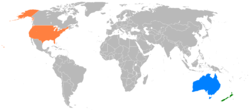
ANZUS ( Eng. ANZUS Security Treaty - Australia, New Zealand, United States ), or the " Pacific Security Pact ", is a military alliance of 3 countries, including:
 Australia
Australia New Zealand
New Zealand U.S.
U.S.
ANZUS is named after the initial letters of the names of the three participating countries ( Eng. A ustralia, N e Z Zaland, United S tates ).
Content
- 1 Conclusion of an agreement on the establishment of ANZUS and subsequent agreements
- 2 Organizational structure of the unit
- 3 Block Tasks
- 4 Analogs ANZUS
- 5 ANZUS Activities
- 6 Sources
- 7 References
- 8 See also
Conclusion of an agreement on the establishment of ANZUS and subsequent agreements

Military cooperation between the United States, Australia and New Zealand began to develop most actively during the Second World War . With the beginning of the Cold War, there was a need to consolidate this cooperation in the form of an organization. The block creation agreement (ANZUS Security Treaty, Pacific Security Pact) was signed in San Francisco (USA) on September 1, 1951 and entered into force on April 29, 1952 . The term of the contract is not limited. Later, separate military cooperation agreements were concluded between:
- USA and Australia,
- Australia and New Zealand,
- USA and New Zealand (until 1987).
Block Organization
The highest governing body is the Council, consisting of foreign ministers or their deputies. A military committee has been created from representatives of the highest military headquarters of the bloc member states. At the same time, the bloc does not have a single supreme command, a combined Armed Forces and a permanent headquarters. The official language of ANZUS working bodies is English .
Block Tasks
ANZUS was created at the initiative of the United States to "coordinate collective defense efforts" in the Pacific , and in 1978, the Indian Ocean was included in the scope of the bloc. Initially, ANZUS was directed against national liberation movements in Southeast Asia and the Pacific region, as well as against the USSR and its allies in Southeast Asia. ANZUS member countries agreed to participate in the Korean and Vietnam wars , intervened in the affairs of Cambodia and Laos .
ANZUS Analogs
During the Cold War, ANZUS was part of pro-American military-political pacts like NATO and CENTO (Baghdad Pact) . Soon after the creation of ANZUS, its members also took part in the preparation of the military-political bloc of SEATO (1956-77) and became a part of it. In addition, in 1971, Australia and New Zealand organized, together with Great Britain , Malaysia and Singapore, another block, similar to ANZUS, ANZYUK , but its activity was very short-lived: in 1974, New Zealand left it, and in 1975 it was dissolved.
ANZUS activities
In 1986, the United States announced its readiness to withdraw from its obligations to ensure the security of New Zealand in connection with the refusal of the latter to allow American ships with nuclear weapons and / or nuclear power plants to enter their ports (a similar problem in 1974-75 led to dissolution of the ANZUS block). The result of the conflict was the formal breakdown of the bilateral agreement on military cooperation between the United States and New Zealand in 1987 .
However, the two-way relationship between the remaining pairs in the bloc (Australia and the USA, Australia and New Zealand) remains strong. All three countries were members of the United Nations International Coalition during the 1991 Gulf War . Australia and New Zealand collaborated on ANZUS during the peacekeeping operation in East Timor in 1999-2002 (and, in fact, later).
At the same time, one of the controversial issues of the bloc remains the problem of Taiwan . In the event of a hypothetical military conflict between the two Chinas , the United States is likely to intercede for Taiwan, which means (under the ANZUS treaty) Australia and New Zealand will follow. However, in 2004-05, the Australian authorities first stated that the agreement allegedly did not apply to such a case, but later refuted this statement. Meanwhile, this event caused a number of unpleasant disputes.
In recent years, ANZUS has been used by the United States to combat international terrorism in the region. After the September 11, 2001 terrorist attack in the United States, Canberra invited Washington to fulfill its allied obligations under the treaty. Also, based on the terms of the ANZUS treaty, Australia and New Zealand take part in the Afghan operation (New Zealand plans to withdraw its troops from Afghanistan in the near future) and participated in the Iraq campaign (New Zealand - until February 2004 , Australia - until July 2009 )
Sources
- Great Soviet Encyclopedia.
- Soviet encyclopedic dictionary.
- A History of New Zealand, Professor Sir Keith Sinclair KBE, Penguin Books, New Zealand, 1991. (Polish)
- ANZUS, w: Słownik polityki, pod redakcją Marka Bankowicza, Wiedza Powszechna, Warszawa 1996. (Polish)
- Lange, David, Nuclear Free: The New Zealand Way, 1991, ISBN 0-14-014519-2 . (eng.)
Links
- Official text of the ANZUS Security Treaty
- Official text of the ANZUS Security Treaty (other source )
- Will New Zealand Reunite with ANZUS? (eng.)
- Center for Disarmament and Security of the New Zealand Peace Fund
- ANZUS Activities (from the history of New Zealand )
- What WikiLeaks reports on New Zealand (New Zealand television material )
- rulers.org
See also
- ANZYUK
- NATO
- SEATO
- CENTO
- SATO
- Vietnam war
- Gulf war
- Afghan war
- Iraq war
- War against terrorism
- ABCA Armies
- AUSCANNZUKUS
- Combined Communications Electronics Board (CCEB)
- Multilateral Interoperability Program (MIP)
- Technical Cooperation Program (TTCP)
- UKUSA Agreement